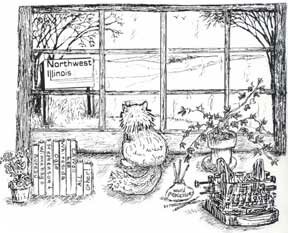
Discover rewarding casino experiences. 
Click on the Flag for More Information |
There is some debate about use of that method among both quilters and history searchers. Here in Illinois little information is found concerning it but perhaps, Back East where the heavyset traffic on the Railroad occurred, it may have been a much used plan. We've talked about this before. The beautifully pieced and sewn blocks shown here, yet to be set together, are the work of friend Betty Martin Fosdick, Savanna, who offered them as an idea to tell what may be known about the U.G.R.R. (Underground Railroad) in our Northwest. Thank you, B. The workmanship is inspiring. Paralleling the Appalachian Mountains Back East the tracks of the Underground Railroad were well worn into the psyches of the Abolitionists who led slaves northward out of bondage. It's estimated that a hundred thousand at least were spirited away on the Railroad between the American Revolutionary War and the Civil War. Cleveland, Ohio was thought to be an important crossroads, a key word in the jargon of the road. Its code name was "Hope" while Detroit was Nearly each neighborhood had a "safe house" but most were SUBposed to be secret. Neighbors didn't usually tell on their neighbors because being a "conductor" on the Railroad was an illegal activity. Yes, it was against the law to help a slave to freedom. They were "property." Slave owners hired slave catchers to track after the runaway and return them. Law officers were obliged to keep an eye out and aid in capture. It was another testing period in American history. This far north in Northwest Illinois there were those for and against expediting the runaway, not so much pro/con slavery but because it was against the law to forward the "property." And, too, many Abolitionists were thought to be fanatics to be steered away from! Not until years later did it become "fashionable" to be a part of the Underground Railroad, if possible. Today during remodeling of an old house folks find "hidey holes" and might call to ask the route of the Railroad. There's said to be one in Savanna and south of Mt. Carroll a few miles. Without some story or legend is it to be known. No proof exists. Most are small, uncomfortable hideouts beneath a stairs or behind a false wall in a closet, a hole under the threshing floor in the barn. The hiding place at the Owen Lovejoy house in Princeton is not at all impressive. Lovejoy was the most well-known conductor on the Railroad in the early day especially following the murder of his brother Elijah Lovejoy in Alton in 1837 because his newspapers so passionately SUBported Abolitionism. Despite what we may think about the issue today only a minority openly SUBported the principles of Anti-Slavery. Not until the Civil War and the Emancipation Proclamation (1862) did the practice become more public to band against slavery though some, such as Owen Lovejoy, worked tirelessly for Anti-Slavery especially when his brother became a martyr in the cause. Lovejoy helped prepare the way in several acts towards Lincoln's Emancipation Proclamation. Few wanted recognition in working for the Underground because, after all, it must remain secret to carry out the traffic. Some felt it their moral duty to assist an individual to escape bondage. Some stories have been found of locals who were openly conductors such as Jacob Baker in Union Grove Township, Whiteside County. The Mississippi River would have been an important pathway north. Before the lock and dam system of the 1930's, the river was much different in character ... Less wide and less turbulent in places, as at the "Narrows," as it was called, at Fulton, Illinois. The Whiteside history, 1877, states a couple places that it was "an easy crossing" so its obvious runaways would seek the best way to cross, then find a Railroad path east-west till the northward journey would continue. Close by was Jacob Baker of whom it was said "He was a radical Abolitionist whose philosophies he brought West with him." Baker was an exception to the rule of silence and subtlety. He made no secret of being a conductor. Before settling in Union Grove he'd lived a while in Ohio where his last political duty was to serve as delegate to the convention electing a nominee to be abolitionist candidate for the presidency. Baker had gotten an "exhorters license" which apparently he'd put to use in both preaching the Methodist message and the Anti-Slavery. It was written that he was "earnest and active in Anti-Slavery issues when it was first being agitated about here in the Fall of 1840." That year, too, the candidacy of James Birney applied nationally for the presidency and to show how little appreciated he was in Illinois, he received only 159 votes statewide. One of them, doubtless, was Baker. To show, however, just how strongly Baker espoused those causes, history relates "He withdrew from the Methodist Church because his views on the anti-slavery issues were objected to." That was in 1844. In just a few months, 1845, Jacob Baker organized a Wesleyan Church which would "sustain the Anti-Slavery movement." Seven others joined him in that church for which he served as delegate to the General Convention in 1848 in New York City and, as well, in Cleveland in 1868. His religious enthusiasm ran as strong as the anti-slavery. He also went to the legislature on that ticket in 1852. It should be said that more than once the Whiteside County history states that to be anti-slavery/abolitionist in the early day meant persecution. One reference says that Elijah Lovejoy "ran slaves to Mr. Baker on the Underground Railroad on their way to freedom." By comparing dates, however, it is found that Lovejoy was murdered two years before Baker came West so it was more probably Owen Lovejoy. He was "nearby" and straight south from Whiteside so more easily in contact. Elijah Lovejoy was far south at Alton.
Of course law officers, slave catchers, bounty hunters and etc. were always on the lookout for "passengers" and "conductors" on the Railroad. Locals could also keep an eye out and did. Not far from Jacob Baker was A.M. Abbott in whose barn was a secret hiding place. Abbott kept a stick to notch each time he passed a runaway on ... Over forty notches decorate the stick. PDQ Me has told about that. Law officers, yes, should, could, did, keep an eye on safe houses for one reason or another. A rather odd situation occurred in Whiteside, however, because its sheriff, Robert Clendenin was Anti-Slavery. His biography records that he was "admirably fitted to discharge the duties of an executive officer being prompt, persevering, fearless and untiring ... He not only had the moral courage but the physical ability to handle evil doers." A few examples of his brave acts are told. Wyatt Earp's deeds pale in comparison! Along with emphasis on his moral courage and personal integrity, it's written that he was an "earnest advocate of the rights of man (so) became a member of the Anti-Slavery party at its early organization. Universal freedom was not a mere hobby with him with which to gain a name and reputation but a fundamental principle that should be enforced. He never let an opportunity pass to practically enforce it. Much more is written concerning Sheriff Clendenin, all in admiring terms but it must have been a somewhat controversial situation to be law officer and anti-slavery, one oft times in conflict with the other according to law. Those people then were all obviously courageous beyond the norm to stand up for the rights of the downtrodden, those held in bondage without voices to be heard except a few scattered here and there across the nation. Hanging out their quilts or carrying "cordwood" or a load of "straw" by moonlight were parts of Railroad scheduling. Clendenin's biographical record ended by its stating that "Those were the days that required nerve to be a friend of freedom." And, "The Underground Railroad had no more efficient engineer than Robert Clendenin. A fugitive fleeing from the chains of servitude in the dark days of slavery always found him ready to afford protection from the pursuers and to assist him to a land where the Fugitive Slave Law had no binding force or effect." Aren't we fortunate, proud, to be able to say those sorts of people were a part of our heritage. They are barely mentioned in our history books. Only a few are so recorded so we might say a silent thank you to those who went unnoticed. NEXT WEEK A FEW MORE.
|





